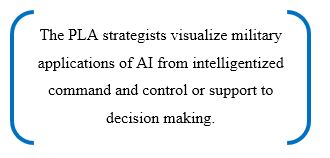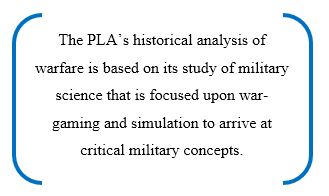Megha Shrivastava, Research Intern, ICS

People’s Liberation Army (PLA) strategists have recognized Artificial Intelligence (AI) as part of the ongoing military revolution, which has immense potential to change the metrics of military power balance in the future and makes AI central to its military modernization plan. Lieutenant General Liu Gouzhi (刘国治), Director of Central Military Commission’s Science and Technology Commission, recognized the disruptive nature of the technology and warned that whosoever does not disrupt will be disrupted. Recently, the fifth plenum of the CCP released its Communique (October 2020), which has emphasized completing informatization and intelligentization by 2027, highlighting the applications of AI in its military modernization plan.
PLA defines AI weapon in its official dictionary as “a weapon that utilizes AI to pursue, distinguish, and destroy enemy targets automatically; often composed of information collection and management systems, knowledge base systems, decision assistance systems, mission implementation systems, etc.” Some PLA thinkers anticipate that future warfare may be fought fully with unmanned autonomous and intelligent weapons systems, including robotic weapons.
PLA’s Initial Trajectory and Long-Term Plan
PLA’s careful study and analysis of the USA’s Third Military Offset Strategy has guided its approach towards AI. It has focused on developing advanced capabilities like unmanned swarms to gain a strategic advantage over the Pentagon’s military potential. Having a competing vision with the US, it is actively planning on accelerating and advancing its technological development with the strong support of the civilian sector through its ambitious Military-Civil Integration (军民融合) program to narrow the gap with US defense capabilities.

While the goals of both countries endeavour to reach the ‘Commanding Heights’ ((制高点), their paths are not the same. Rather, the PLA has adopted the strategy of ‘Overtaking on the Curve’ to catch up and bypass the US and Russia. Beijing will strive towards prioritizing defence innovation through military intelligentization (智能化) and Chinese ‘Superintelligence’ (Brain-inspired intelligence), which creates the fear of shaping an entirely new domain of cognitive warfare.
To catch up with its overwhelming aspirations, China’s 2019 Defence White Paper emphasizes early informatization (信息化), which will facilitate intelligentization in warfare (智能化作战). The PLA strategists visualize military applications of AI from intelligentized command and control or support to decision making. Some PLA strategists believe that in the future, the intelligentization of warfare may result in battlefield singularity (奇异), which will help in making the best use of human and machine capability.
Leveraging AI for Warfare
PLA defines war as a scientific concept that can be deconstructed, and AI is more suited to predict calculated outcomes or to identify the adversary’s vulnerable systems. Thus, the asymmetric thinking of targeting adversary’s vulnerability will remain a central theme in leveraging AI applications.
It is likely to leverage AI to strengthen its military capability not only towards intelligentization but also to gradually develop advanced autonomous and unmanned vehicles, war-gaming, and data fusion. Further, it will leverage the potential of associated technologies like 5G, Quantum computing, the internet of things, etc. to assist its strategies related to warfare in general and Information Warfare (cyber and electronic warfare) in particular. It can support and enhance PLA’s psychological warfare capabilities to target combatant’s behaviours and emotions.

PLA thinkers argue that AI should be used both kinetically and non-kinetically to dominate the information domain and target the enemy’s information networks. They believe that a ‘system of systems’ warfare will occur as a result of ubiquitous networks. These networks will diminish the distance between action, decision-making, and perception. With PLA recognizing that modern warfare is “system’s confrontation” (系统浓度) (a system versus system conflict) and information dominance is essential to achieve dominance in other domains, the emphasis on the application of AI to achieve information dominance can be understood. With such an edge, PLA seeks to pursue the style of mosaic warfare with Chinese characteristics. Its ultimate goal of leveraging AI is directed toward achieving a cognitive advantage over its adversaries while being able to defend its system of systems.
AI in Decision Making
On the question of keeping humans ‘in the loop’(在循环) of decision making, it is quite uncertain and may be too early to predict. However, strategic thinking towards AI predicts that PLA might increasingly favour intelligible and cognitive decision making rather than human judgments. They believe that PLA is likely to integrate command-and-control systems into built-in systems by designing and operationalizing plans in advance. Also, the PLA’s historical analysis of warfare is based on its study of military science that is focused upon war-gaming and simulation to arrive at critical military concepts. It will thus incorporate AI to formulate appropriate military theories and tactical decisions. This may also disrupt the OODA (Observe, Orient, Decide, and Act) loop given by Col. John Boyd, and that is also frequently discussed by PLA thinkers. Former US Deputy Secretary of Defence Bob Work believes the authoritarian regimes and those who believe in the weaknesses of humans and rely heavily on machines are more inclined to move toward fully autonomous weapons and to keep humans out of the loop. It is likely that the decision to put human ‘in the loop’, ‘on the loop’ or ‘out of the loop’ shall rather be determined based on the lethality and criticality of the system, and PLA may adopt a combination of all three to meet the perceived threat.

The Bigger Picture
At this stage, the extent to which militaries will be able to harness the potential of AI in decision making is difficult to predict. However, the ongoing military modernization process suggests that PLA will emphasize integrating AI in its reconnaissance and surveillance system, weapons systems and, command, control, and communication structures apart from training and supervision of personnel under its efforts to make PLA truly modernized by 2027. The High-End Laboratory for Military Intelligence (HELMI), which was set up at Tsinghua University in 2018, is serving as a breakthrough point for developing what China calls “AI superpower strategy”. Today, China is behind in AI and semiconductors, and present trends suggest that the gap will narrow soon in the future. These are the key government priorities, receiving enormous attention and investment.
Disruptions led by militarized AI will be decisive for the future of warfare. AI is here to stay and develop to surprising levels in times to come shaping military innovation, nature of the conflict, and warfare in the 21st century. Only time will tell whether the disruption will be China-led or American. If the PLA succeeds well in materializing the potential of AI, it will turn out to be a game-changer, thereby placing greater challenges for future military power balance, peace, and stability.